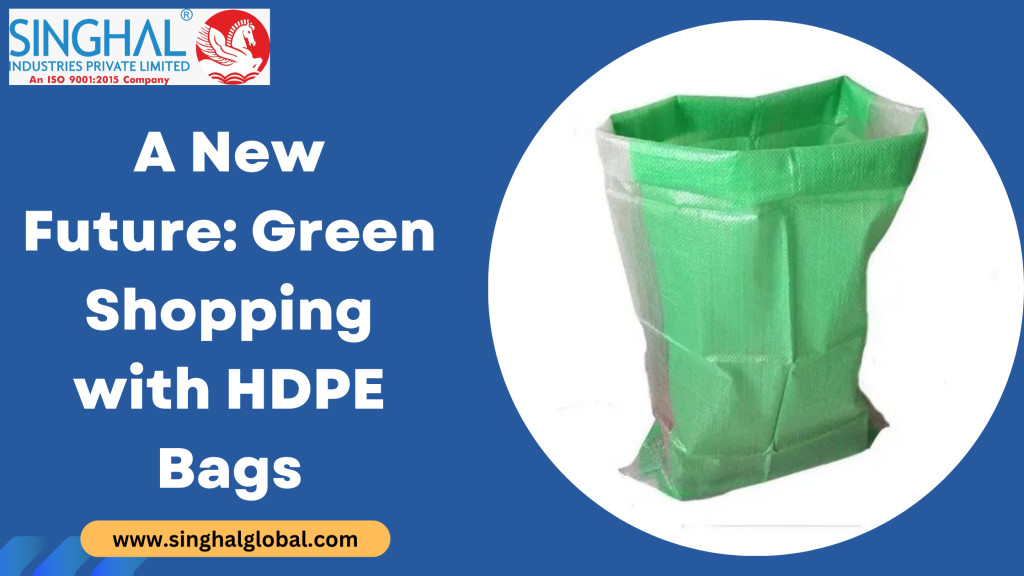Even as consumer and business awareness of environmental implications of plastic has grown steadily for years now, the market has gradually shifted toward more sustainable materials. Of the alternatives to traditional plastic shopping bags, high-density polyethylene bags stand out as being one of the most promising mediums for green shopping. As long as low-density polyethylene or other plastic bags have been the norm of retail packaging for decades, HDPE bags possess few crucial advantages that make the decision to be green and forward for an environmentally friendly future achievable. Singhal Industries is a well-known & leading HDPE bags suppliers in the country. In this article, we will learn why HDPE bags represent not just an environmentally friendly choice but the future for responsible shopping.
What Are HDPE Bags?
HDPE is an abbreviation to High-Density Polyethylene. It is a thermoplastic polymer found from petrochemical materials. The bags produced from this polymer are strong and persistent and have relatively low environmental effects. They are compared to other plastics. Generally, HDPE is used in grocery and clothing carrying and other items because of their strength and affordability.
HDPE bags are usually thicker and more rigid than their LDPE counterparts, which makes them much stronger and resistant to punctures. Being more robust due to their molecular structure allows for repeated use, making them a sustainable option compared to the old single-use plastic bag.
Key Benefits of HDPE Bags
1. Recyclability
One of the most significant advantages of HDPE bags is that they are very recyclable. Association of Plastic Recyclers says that HDPE has an excellent recycling rate as most curbside collection programs accept HDPE products. A lot of things can be made from recycled HDPE such as new bags, containers, bottles, and even construction materials. In reality, recycling HDPE saves the demand for fresh plastic with less tapping of natural resources and less energy.
Widespread availability of HDPE recycling programs make it easier for consumers to recycle the bags post-use, keeping it out of the landfill and reducing the environmental footprint associated with plastic waste.
2. Lower Carbon Footprint
Though plastics in general are quite energy-intensive, HDPE has the smallest carbon footprint of most other kinds of plastic bags, including even low-density polyethylene. They use less raw material and also require less energy to produce many others, thus making them more resource-friendly. Besides, since they are stronger and may be used more than once, they prolong their life even more than the other types of disposable plastic that then consequently implies less overall environmental impact.
Many producers have also started adopting a process that is more energy-efficient, along with renewable sources of energy, in producing HDPE; hence, carbon emissions reduction has been increased.
3. Strength and Durability
HDPE bags are stronger than the traditional plastic bags, meaning they can be used multiple times before they begin to fray and wear out. The strength enables carrying huge loads without causing rips or breaking, which is what mostly happens to most traditional plastic bags. For an environmentally sensitive shopper, this is an advantage in that the reduction of constant changes would imply lower usages of plastics. If you are looking to purchase HDPE bags then always purchase it from best HDPE bags manufacturer.
Another reason is that HDPE bags are weather-resistant; it does not break down easily, making it last longer than other plastics, which commonly tend to become brittle and fragile over time.
4. Minimal Plastic Waste
The minimal plastic waste is quite an important aim in a moment when the plastic pollution issue reaches new heights every day. HDPE bags contribute to minimal plastic waste in two major ways:
–They reduce the number of disposable plastic bags that add to the wasteful system. They are tough and, therefore, allow multiple usage.
–They are recyclable: When the HDPE bags have been used for as long as they can be used, they can be effectively processed and become a new commodity by being recycled and not using virgin plastic.
–Reuse and recyclable: HDPE bags play an important role in the circular economy, where materials and products are reused, refurbished, and recycled to create a better production and consumption model . To know the best HDPE bags price per kg just contact us at Singhal Industries.
5. Non-toxic and safe for human
Unlike other types of plastics, HDPE is free from harmful chemicals like BPA which might leak to foods and drinks.
In addition, HDPE bags are FDA-approved for food contact, allowing consumers and retailers to have peace of mind.
For conscious environmental shoppers, it is a key advantage that also ensures material usage for any purchase is environmentally friendly and safe and nontoxic to use normally.
6. Water Resistance and Non-stick Nature of the Material
HDPE bags are also waterproof. Because it is not absorbing any moisture, it will not be soft and soggy during wet conditions. It is easier to clean the bags because when some spills and stains occur, these can just be wiped off with ease. As a lot of shopaholics are now more conscious about the environment, it is preferable to have reusable bags made of HDPE. Because it doesn’t absorb moisture, these are not easily damaged or soggy in wet conditions.
7. Cost-Effective and Light
Although HDPE bags are tougher and recyclable, they are even less expensive to make than HDPE, hence making them a cheap substitute not only for the retailers but also to consumers. Hence, all these businesses will easily sell these packets at a lesser price or perhaps provide them free of charge as their endeavor towards reducing plastic wastes and maintaining sustainable buying practices.
HDPE bags are also lightweight, which reduces the energy needed to transport and makes them easier to handle. Again, this serves to increase the efficiency as well as the environmental sustainability of the supply chain, making their overall sustainability profile even more attractive.
8. The Role of HDPE Bags in Sustainable Retail Change
This is quite an important transition that retail takes towards more sustainable practices. Already, with many businesses opening their eyes to the environment and economic benefits of HDPE bags, we already see the growth of adopting retailers within their sustainability initiatives. For instance, many large grocery chains are already offering HDPE bags as an alternative to single-use plastic and are encouraging consumers to bring along their own reusable HDPE bags.
Governments of other countries around the globe begin legislating against single-use plastic bags to add to the growing demand for sustainable alternatives. In some countries, policy initiatives have been employed with the aim of controlling plastic bag use through tax charges or proscribing sales. This has helped build a supportive environment in which HDPE bags can thrive as an emerging solution to plastic waste at both the level of the consumer and of policy.
Conclusion
HDPE bags indeed are innovative solutions in combating plastic pollution. They are recyclable and very sustainable with minimal environmental impact, thus forming a better alternative to the other plastic bags.
More than a greener option for the green-conscious shopper, HDPE bags are born to play a significant part in reshaping retail packaging for the future of this world’s continued pursuit of sustainability. HDPE bag solutions enable consumers and businesses to be part of a circular economy that reduces waste, conserves resources, and ensures a cleaner and better future for everyone.
Frequently Asked Questions (FAQs)
What makes HDPE bags so durable?
HDPE molecules are securely packed and linked, so this plastic is relatively tough, strong, and resistant. Therefore, HDPE is widely utilized in the manufacture of toys, cans, pipes, and tubing.
Can HDPE bags handle temperature extremes?
The softening point of HDPE lies within 210-220°F. Furthermore, it is quite tolerant to low temperatures. In fact, the embrittlement temperature of HDPE ranges at approximately minus 180°F.
Are HDPE bags safe for food storage?
HDPE bags possess good barrier properties against unfavorable external factors that could be detrimental to the packaged food in terms of quality and safety.
How can I recycle my HDPE bags responsibly?
There are various plastic wrap and bags that one can reprocess at many supermarkets and retailers.









